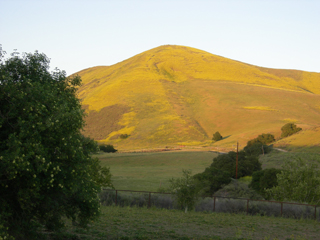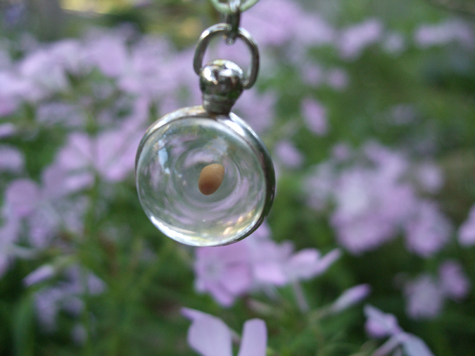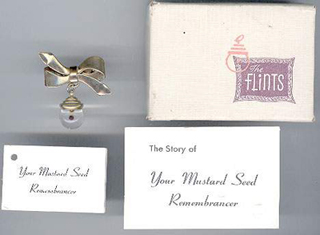Human Flower Project
Wednesday, April 30, 2008
Faith, Realism, Enterprise: All in a Mustard Seed
A talisman from the 1960s reaches back two centuries and forward, to this very spring in California.

Sunset on mustard-covered hills, Tepusquet Canyon, California
Photo: Caroline Joyes Woods
“It is so completely covering our hills right now,” writes Caroline Joyes Woods, “that you can smell its honey-with-a-dash-of-fetid (the fetid being just a tiny after-smell) fragrance in the morning when you first come out and the air is still and the moisture still in the air…nice!”
“It” is mustard, and “our hills” are Tepusquet Canyon, near Santa Maria, California, where Caroline and her husband have been ranching for many years. “Nice” and a lot more than that is Caroline herself, a childhood friend, apple tree climber, and moss garden maker.
We contacted her this spring having dimly remembered a human flower project from back in the early 1960s. When we were still in elementary school, Caroline used to wear around her neck a silver chain and glass amulet with a mustard seed encased inside. We went treasure hunting and were thrilled to find one several weeks ago at Uncommon Objects here in Austin. But aside from, now, being souvenirs of childhood, what were these charms all about?
Caroline reminded us that Christ told his disciples “If ye have faith as a grain of mustard seed-nothing shall be impossible unto you.” (Matthew 17:20) In several of the gospels Jesus also compares the kingdom of heaven to a mustard seed “which a man took, and sowed in his field: Which indeed is the least of all seeds: but when it is grown, it is the greatest among herbs, and becometh a tree, so that the birds of the air come and lodge in the branches thereof.” (Matthew 13:31-2)

Mustard seed “Remembrancer” and prairie phlox (Phlox pilosa)
Photo: Human Flower Project
Someone turned the parable into a trinket that caught on. A few clicks through ebay (and the trip to Uncommon Objects, too) proved how popular these items once were—though somehow we can’t imagine preteens of today much going for them. It turns out they were manufactured by the Flint Company, a mom and pop operation in Kansas City. In Richard Weiss’s book The American Myth of Success, we learn about Maurice and Alice Flint, a Missouri couple who had fallen on hard times after World War II. They consulted Norman Vincent Peale, a leading pop-religious figure of the time (Dr. Phil, Billy Graham, and Donald Trump rolled into one).
Weiss writes that it was Peale “who advised them to repeat the following New Testament injunction whenever they felt despondent: ‘If ye have faith as a grain of mustard seed…nothing shall be impossible unto you.’ Flint asked his wife for a mustard seed to carry as a reminder, and she obliged with one from the family pickle jar. One day, feeling low, he reached into his pocket for the seed, but it was gone.” He then struck on the idea of capturing a mustard seed in a protective container and started making costume jewelry. “The Remembrancer,” as he dubbed it, “was advertised a ‘Symbol of faith – a genuine mustard seed enclosed in sparkling glass, makes a bracelet with real meaning.’”
 Remembrancer pin and cards from the Flint Co.
Remembrancer pin and cards from the Flint Co.
Photo: Collectible Jewels
The Flints opened a charm factory and did very well, it appears; according to Peale, “These articles sold like hot cakes.”) “The Remembrancer” was being marketed at least by 1951, and Caroline was wearing hers in 1964. A good streak.
The mustard seed also makes an appearance in Buddhist legend, and, as you might guess, conveys a very different message.
A woman named Kisa Gotami was wandering in grief, after the death of her only child. “Her sorrow was so great that many thought she had already lost her mind.” Pleading for help, she went to the Buddha, who promised to bring her son back to life—if she could gather “white mustard seeds from a family where no-one had died. She desperately went from house to house, but to her disappointment, every house had someone who had died. Finally the realization struck her that there is no house free from death.” She was renewed, and comforted, and continued on the path toward enlightenment. (We don’t know if the Remembrancer ever caught on among Buddhists.)
Are these the same story or contradictory stories? Can “When you wish upon a star” be the same as “Wake up and smell the mustard”? We’re not sure, but Caroline seems to have found faith and truth in bloom together—“honey-with-a-dash-of-fetid.” Nice going, old friend!
Culture & Society • Religious Rituals • Secular Customs • Permalink




